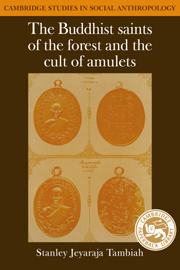Book contents
- Frontmatter
- Contents
- Acknowledgments
- Note on transcription
- 1 Introduction and manifesto
- Part I The arahant and the Path of Meditation
- Part II The hagiography of a Buddhist saint: text and context; the politics of sectarianism
- 6 The biography of a modern saint
- 7 The Buddha's life as paradigm
- 8 The ordering principles behind Buddhist saintly biography
- 9 The disciples of the Master
- 10 The biographer as exemplary forest-monk, meditator, and teacher
- 11 Sectarianism and the sponsorship of meditation
- 12 The Mahānikāi sect's propagation of lay meditation
- 13 The center–periphery dialectic: the Mahāthāt and Bovonniwet sponsorship of meditation compared
- Part III The cult of amulets: the objectification and transmission of charisma
- Part IV Conceptual and theoretical clarifications
- Notes
- Index
- CAMBRIDGE STUDIES IN SOCIAL ANTHROPOLOGY
12 - The Mahānikāi sect's propagation of lay meditation
Published online by Cambridge University Press: 10 December 2009
- Frontmatter
- Contents
- Acknowledgments
- Note on transcription
- 1 Introduction and manifesto
- Part I The arahant and the Path of Meditation
- Part II The hagiography of a Buddhist saint: text and context; the politics of sectarianism
- 6 The biography of a modern saint
- 7 The Buddha's life as paradigm
- 8 The ordering principles behind Buddhist saintly biography
- 9 The disciples of the Master
- 10 The biographer as exemplary forest-monk, meditator, and teacher
- 11 Sectarianism and the sponsorship of meditation
- 12 The Mahānikāi sect's propagation of lay meditation
- 13 The center–periphery dialectic: the Mahāthāt and Bovonniwet sponsorship of meditation compared
- Part III The cult of amulets: the objectification and transmission of charisma
- Part IV Conceptual and theoretical clarifications
- Notes
- Index
- CAMBRIDGE STUDIES IN SOCIAL ANTHROPOLOGY
Summary
The lay popular religiosity of the seventies as observed in Bangkok showed, among others, two contrapuntal interests and activities. One was the general interest, especially among the middle class and educated urban categories (and among them, especially the elderly and the retired) in the practice of meditation. Instruction was taken from monk, sometimes lay, teachers, and collective sittings were held in the halls of wat at set times, especially on wanphra and Sundays. In a general sense, this show of interest in meditation has intensified in recent years with the spread of literacy and education, with the translation into the local language of Pali texts, and with the accompanying realization that meditational exercises are not the sole province of the monk. In a sense, then, when increasing numbers of laymen observe the eight or ten precepts on wanphra, and congregate at wat for meditational sittings, the layman–monk distinction as portraying totally different regimes and styles of life is blurred. Nevertheless, there is a striking contrast between the forest ascetic monk totally devoted to meditation and the search for liberation on the one hand, and on the other hand the educated informed layman practicing occasional meditation to lend him some tranquility and detachment from the cares, stresses, and involvements of a layman's life in the world.
At first sight, the lay interest in meditation seems to contradict the widespread lay interest in the traffic in and possession of amulets, which are believed to possess efficacious life-giving and life-protecting powers that have been transferred to and objectified in them by the world-transcending meditation masters and forest saints.
- Type
- Chapter
- Information
- The Buddhist Saints of the Forest and the Cult of Amulets , pp. 168 - 182Publisher: Cambridge University PressPrint publication year: 1984



